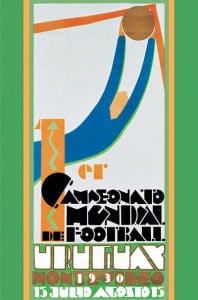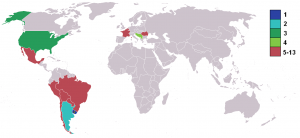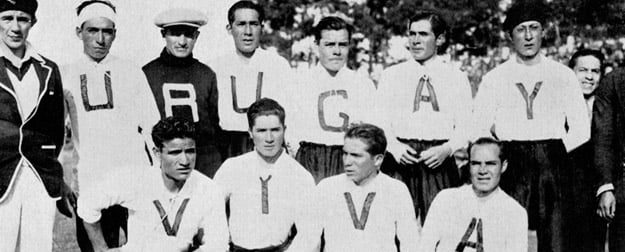Door Anne Brugts, Story Terrace
A South American affair – The very first football World Cup in 1930
Those who can’t find any interest in twenty-two gentlemen running after a ball on a green grassy lawn will find themselves in a difficult position at the moment. The World Cup in Brazil attracts a record level of media and public attention. Interest in the first World Cup in 1930 was at a somewhat different level, however.

In the early 20th century, countries would meet for games of football on a European scale of competition and at the Olympics. But in 1930 the Fédération Internationale de Football Association (FIFA) decided it was time to organize a global tournament just for football. The idea for World Cup football was born.
For the very first staging of World Cup football, Uruguay was selected to be the host country. The Netherlands had also been nominated, but Uruguay was granted the honour as a reward for winning gold in the recent Olympic football championship in 1928. Moreover, the World Cup tournament was to crown Uruguay’s celebration of the 100-year anniversary of its constitution.
Political lobby
While the World Cup 2014 attracted 203 countries to sign up for qualifying matches, in 1930 the applications failed to flock in. In fact, there was little European enthusiasm for participation. The costliness of the long journey, combined with the need to spend several weeks away from home, appeared too great an obstacle for many national teams. By the time the deadline for entries had passed, not one European team had submitted an application to play in the World Cup.
 On the initiative of the former chairman of FIFA, Jules Rimet, a political lobby set out to convince European nations to join the tournament. This resulted in applications from Belgium, France, Yugoslavia and Romania. Although the Netherlands had earlier competed to be host country, they later renounced all participation.
On the initiative of the former chairman of FIFA, Jules Rimet, a political lobby set out to convince European nations to join the tournament. This resulted in applications from Belgium, France, Yugoslavia and Romania. Although the Netherlands had earlier competed to be host country, they later renounced all participation.
Victoria o muerte
The other participants were mainly from the South American continent. Thus, the 1930 World Cup became chiefly a Latin American affair. The affair came to a climax in the final, when the host country Uruguay competed with neighbouring Argentina.
For the Argentinians, who had travelled from Buenos Aires by ferry, this match was meant to offer revenge for losing the final of the Olympic Games in 1928. To them, this was going to be a game of life or death. Their determination rang out clearly in their slogan ‘victoria o muerte’ (victory or death), which resounded from the Argentinian corners of the stadium throughout the entire match. Despite the battle cries, though, Argentina lost this final and Uruguay fledged its wings with the first World Cup championship.
The World Cup as a global institution
Although clearly the first World Cup wasn’t a global attraction, interest steadily grew after this first event. The following World Cup tournament in 1934 attracted far more European competitors than in 1930. Its location in Italy, allowing teams to travel there by train, must have had something to do with that. Overall, the foundations that were laid in those early years made it possible for the World Cup in the following decades to grow into the global institution it is today.
_______
About us: Story Terrace helps customers to capture personal stories in short books alongside professional writers. Our writers have a range of backgrounds and interests, sharing one passion: Portraying individuals through carefully crafted anecdotes and connected stories.
This month we celebrate World Cup memories. Also see our interview with Dutch field hockey international Kim Lammers (33) and other articles. What’s your favourite World Cup memory?



